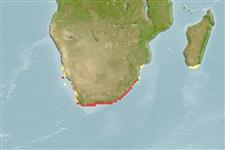>
Mugiliformes (Mullets) >
Mugilidae (Mullets)
Etymology: Pseudomyxus: Name from the genus Myxus preceeded by Greek prefix 'pseudo' meaning 'false'..
More on author: Valenciennes.
Environment: milieu / climate zone / depth range / distribution range
Ecologia
marino; acqua dolce; salmastro demersale; catadromo (Ref. 51243). Subtropical; 25°S - 35°S
Africa: endemic to South Africa, in east coastal estuaries and rivers from the Breë River to Kosi Bay (Ref. 7248, 52193).
Length at first maturity / Size / Peso / Age
Maturity: Lm 23.0 range ? - ? cm
Max length : 45.0 cm FL maschio/sesso non determinato; (Ref. 52193)
Spine dorsali (totale): 5; Raggi dorsali molli (totale): 8; Spine anali 3; Raggi anali molli: 9.
Adults occur in freshwater to estuarine conditions. Adults breed at sea, throughout the year; juveniles move into estuaries and enter rivers usually in late winter or early spring (Ref. 52193). Females remain in freshwater for 7 years, males for 4 years (Ref. 52193). Return to estuaries before maturing sexually prior to spawning (Ref. 52193). Oviparous, eggs are pelagic and non-adhesive (Ref. 205). Feed on benthic algae and small invertebrates over muddy bottom (Ref. 6465). Decline in population from obstruction, by dams and weirs, of free passage into rivers.
Life cycle and mating behavior
Maturità | Riproduzione | Deposizione | Uova | Fecundity | Larve
Breed at the sea throughout the year. Juveniles move into estuaries and enter rivers usually in late winter or early spring. Males remain in freshwater until 4 years, females for up to 7 years. Fish return first to estuaries before maturing sexually prior to spawning (Ref. 7248).
Thomson, J.M., 1986. Mugilidae. p. 344-349. In J. Daget, J.-P. Gosse and D.F.E. Thys van den Audenaerde (eds.) Check-list of the freshwater fishes of Africa (CLOFFA). ISNB, Brussels, MRAC; Tervuren; and ORSTOM, Paris. Vol. 2. (Ref. 3573)
IUCN Red List Status (Ref. 130435)
Threat to humans
Harmless
Human uses
Pesca: commerciale; Acquario: Commerciale
Informazioni ulteriori
CollaboratoriImmaginiStamps, Coins Misc.SuoniCiguateraVelocitàModalità di nuotoArea branchialeOtolithsCervelliVista
Strumenti
Special reports
Download XML
Fonti Internet
Estimates based on models
Preferred temperature (Ref.
123201): 15.3 - 24.9, mean 22.6 °C (based on 20 cells).
Phylogenetic diversity index (Ref.
82804): PD
50 = 1.0000 [Uniqueness, from 0.5 = low to 2.0 = high].
Bayesian length-weight: a=0.01175 (0.00668 - 0.02065), b=2.96 (2.81 - 3.11), in cm total length, based on LWR estimates for this species & (Sub)family-body (Ref.
93245).
Trophic level (Ref.
69278): 2.8 ±0.27 se; based on food items.
Resilienza (Ref.
120179): Medio, tempo minimo di raddoppiamento della popolazione 1.4 - 4.4 anni (Preliminary K or Fecundity.).
Fishing Vulnerability (Ref.
59153): Moderate vulnerability (40 of 100).
